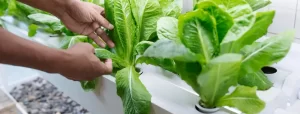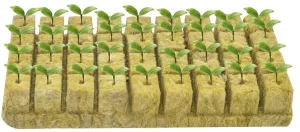Rockwool Growing Medium for Hydroponics 2023

Table of Contents
Hydroponic gardening is a highly effective and sustainable way to grow plants without soil. One of the keys to successful hydroponics is choosing the right growing medium.
A growing medium is the material used to support and anchor the roots of plants in a hydroponic system, and it also provides a medium for nutrient delivery.
Rockwool growing medium for hydroponics is a famous choice, a lightweight, porous material made from spun basaltic rock fibers.
Rockwool is highly versatile and can be used for seed germination, cloning, and plant growth in a variety of hydroponic systems. In this blog post, we’ll explore the benefits of using Rockwool in hydroponics, how to use it effectively, and tips for successful plant growth.
What are the advantages of using Rockwool Growing Medium for Hydroponics
There are several advantages of using Rockwool as a growing medium in hydroponics. Here are some of the key benefits:
- Excellent water retention: Rockwool has the ability to hold up to 20 times its weight in water, which makes it an excellent growing medium for hydroponics. It helps to ensure that plants have access to water, even in dry or arid climates.
- Neutral pH: Rockwool is pH neutral, which means that it doesn’t affect the pH levels of the nutrient solution in hydroponic systems. This is important because pH levels can affect the availability of nutrients to plants.
- Resistant to pests and diseases: Rockwool is resistant to pests and diseases that can affect plants grown in soil. This helps to reduce the need for pesticides and fungicides in hydroponic systems.
- Reusable: Rockwool can be reused multiple times, making it a cost-effective option for hydroponic growers. It can be sterilized and reused for future crops.
- Easy to use: Rockwool is easy to use and can be cut or shaped to fit any hydroponic system. It’s also lightweight and easy to transport.

How to use rockwool in hydroponics
- Soak the Rockwool: Before using Rockwool, it’s important to soak it in water for at least an hour to ensure that it’s fully hydrated.
- Prepare the Rockwool: Once the Rockwool is soaked, remove it from the water and gently squeeze out any excess water. Then, cut the Rockwool into small cubes or slabs, depending on your hydroponic system and the size of your plants.
- Plant seeds or cuttings: Using a small hole or slit, plant the seeds or cuttings into the Rockwool, ensuring that they are fully inserted and in contact with the growing medium.
- Water the plants: After planting, water the Rockwool to ensure that it’s fully saturated and that the plants have access to water and nutrients.
- Monitor the plants: Monitor the plants regularly to ensure that they’re growing well and that they’re getting enough water and nutrients. Adjust the pH levels and nutrient solution as needed.
- Replace the Rockwool: Once the growing cycle is complete, the Rockwool can be removed from the hydroponic system, sterilized, and reused for future crops.
What types of hydroponics systems use rockwool
- Drip irrigation systems: In a drip irrigation system, nutrient-rich water is dripped onto the Rockwool cubes or slabs, providing the plants with the necessary water and nutrients.
- Ebb and flow systems: In an ebb and flow system, the Rockwool cubes or slabs are placed in a tray that is periodically flooded with nutrient-rich water, which is then drained away. This allows the plants to absorb the necessary water and nutrients.
- Nutrient film technique (NFT) systems: In an NFT system, a thin film of nutrient-rich water flows over the Rockwool cubes or slabs, providing the plants with a constant supply of water and nutrients.
- Aeroponic systems: In an aeroponic system, the Rockwool cubes or slabs are suspended in the air, and a mist of nutrient-rich water is periodically sprayed onto the roots of the plants.
- Vertical farming systems: In a vertical farming system, the Rockwool cubes or slabs are arranged in vertical stacks, allowing for maximum use of space and efficient water and nutrient delivery to the plants.
Tips for success when using rockwool
- Properly soak the Rockwool: Before using Rockwool, it’s important to soak it in water for at least an hour to ensure that it’s fully hydrated. This will help to ensure that the Rockwool has the necessary water-retention properties.
- Maintain proper pH levels: As mentioned earlier, Rockwool is pH neutral, which means that it won’t affect the pH levels of the nutrient solution. However, it’s important to monitor the pH levels of the nutrient solution regularly and adjust as needed to ensure that the plants are getting the right balance of nutrients.
- Sterilize the Rockwool: Before reusing Rockwool, it’s important to sterilize it to prevent the spread of pests and diseases. This can be done by soaking the Rockwool in a solution of hydrogen peroxide or bleach.
- Provide adequate drainage: Rockwool should be placed in a container or tray with adequate drainage to prevent water from accumulating and drowning the plants. Ensure that the drainage holes are not blocked.
- Monitor the nutrient solution: Check the nutrient solution regularly to ensure that it’s at the proper strength and pH level. Adjust as needed to ensure optimal plant growth.
- Keep the growing environment clean: As with any hydroponic system, it’s important to keep the growing environment clean to prevent the buildup of harmful bacteria and fungi. Regularly clean and sanitize the system and equipment.
Conclusion
In conclusion, Rockwool is a popular and versatile growing medium used in hydroponics that offers a range of benefits. It provides excellent water retention, while also allowing for good air circulation, which can be beneficial to plant roots.
Additionally, Rockwool is pH neutral and can be used in a variety of hydroponic systems, making it a popular choice among growers.
However, it’s important to properly soak and prepare the Rockwool, maintain proper pH levels, sterilize it before reuse, provide adequate drainage, monitor the nutrient solution, and keep the growing environment clean to ensure optimal plant growth.
By following these tips, hydroponic growers can successfully use Rockwool as a growing medium and achieve healthy and robust plant growth.
For further and more in depth read, you can check Growing in Rockwool (Grower Manuals)
FAQs
Can you use Rockwool as a growing medium in hydroponics?
Yes, Rockwool can be used as a growing medium in hydroponics. In fact, it is a popular choice because it is lightweight, easy to handle, and holds water well. Rockwool is made from melted rock that is spun into fibers and then formed into blocks or slabs.
To use Rockwool in hydroponics, you will need to soak it in water with a pH of around 5.5-6.0 for several hours before planting your seeds or seedlings. This will help to neutralize the pH of the Rockwool and remove any excess mineral salts that may be present.
Once the Rockwool is saturated with water, you can plant your seeds or seedlings directly into it. Make sure to keep the Rockwool moist by regularly watering it with a nutrient solution that is specifically formulated for hydroponic use.
One thing to keep in mind when using Rockwool in hydroponics is that it can be difficult to dispose of. Rockwool is not biodegradable, so it is important to dispose of it properly by recycling or sending it to a landfill that accepts this type of material.
Is rockwool good for hydroponics?
There are several reasons why Rockwool is a good choice for hydroponics:
Water retention: Rockwool holds water well, which is important for hydroponics because it allows plants to have continuous access to water and nutrients.
pH neutral: Rockwool is pH neutral, which means that it does not affect the pH of the nutrient solution that is used in hydroponics. This makes it easier to maintain the pH of the nutrient solution at the optimal level for plant growth.
Sterile: Rockwool is an inert and sterile growing medium, which means that it is free from pathogens and pests that can harm plants. This reduces the risk of disease and allows plants to grow in a clean and healthy environment.
Versatility: Rockwool can be used for a wide range of crops, from small herbs to large vegetables. It is also easy to handle and can be cut to size for different applications.
Is rockwool a good growing medium?
Rockwool is a good growing medium for many plants. Rockwool is made from spun fibers of rock and is designed to provide good drainage and aeration for plants while also retaining moisture.
What is the disadvantage of rockwool in hydroponics?
While Rockwool is a popular and effective growing medium for hydroponics, there are some potential disadvantages to using it:
Environmental concerns: Rockwool is not an environmentally friendly material as it is made from spun fibers of rock and is not biodegradable. This means that it can be difficult to dispose of, and it can contribute to waste and pollution.
Irritation: Rockwool can cause skin and respiratory irritation if not handled properly. It is important to wear protective gloves and a mask when handling Rockwool.
pH fluctuations: While Rockwool is pH neutral when it is manufactured, it can become acidic over time as it interacts with the nutrient solution. This can cause pH fluctuations that can negatively impact plant growth.
Overwatering: Rockwool can retain a lot of moisture, which can lead to overwatering if not properly managed. Overwatering can cause root rot and other plant diseases.
Cost: Rockwool can be more expensive than other growing media, such as coconut coir or peat moss.
Does rockwool affect pH?
Rockwool has a neutral pH when it is manufactured, which means that it should not have an impact on the pH of the nutrient solution used in hydroponics. However, over time, Rockwool can become acidic as it interacts with the nutrient solution. This can cause pH fluctuations that can negatively impact plant growth.
To prevent pH fluctuations, it is important to monitor the pH level of the nutrient solution regularly and adjust it as needed. This will help to ensure that the pH level remains within the optimal range for plant growth. It is also recommended to pre-soak Rockwool in water with a pH of around 5.5-6.0 before planting to help neutralize the pH of the Rockwool and remove any excess mineral salts.
It is worth noting that while Rockwool is pH neutral, other factors in your hydroponic system can affect the pH level of the nutrient solution. For example, if your water source has a high or low pH




